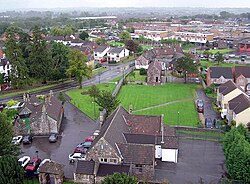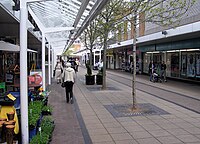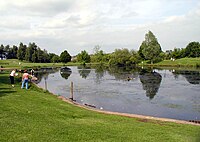Yate: Difference between revisions
m clean up, typos fixed: tthe → the, build up → buildup |
No edit summary |
||
| Line 14: | Line 14: | ||
|constituency=Thornbury and Yate | |constituency=Thornbury and Yate | ||
}} | }} | ||
'''Yate''' is a town in [[Gloucestershire]], at the | '''Yate''' is a town in [[Gloucestershire]], at the south-west extremity of the [[Cotswolds|Cotswold Hills]], 12 miles north-east of the city of [[Bristol]]. At the 2001 census the population was 21,789. The town of [[Chipping Sodbury]] (population 5,066) is contiguous with Yate to the east. | ||
Yate developed from a village into a new town in the 1960s, partly as an overspill or commuter town for | Yate developed from a village into a new town in the 1960s, partly as an overspill or commuter town for Bristol. | ||
The town is surrounded by countryside and within reach | The town is surrounded by countryside and within reach of Bristol by bicycle, car, bus or train. Yate railway station serves the town. The station is located on the main Bristol to Birmingham line between Bristol Parkway and Cam and Dursley. | ||
==Church== | ==Church== | ||
Latest revision as of 11:06, 4 January 2019
| Yate | |
| Gloucestershire | |
|---|---|
 Yate from the tower of St Mary's Church | |
| Location | |
| Grid reference: | ST7182 |
| Location: | 51°32’25"N, 2°24’40"W |
| Data | |
| Population: | 21,789 |
| Post town: | Bristol |
| Postcode: | BS37 |
| Dialling code: | 01454 |
| Local Government | |
| Council: | South Gloucestershire |
| Parliamentary constituency: |
Thornbury and Yate |
Yate is a town in Gloucestershire, at the south-west extremity of the Cotswold Hills, 12 miles north-east of the city of Bristol. At the 2001 census the population was 21,789. The town of Chipping Sodbury (population 5,066) is contiguous with Yate to the east.
Yate developed from a village into a new town in the 1960s, partly as an overspill or commuter town for Bristol.
The town is surrounded by countryside and within reach of Bristol by bicycle, car, bus or train. Yate railway station serves the town. The station is located on the main Bristol to Birmingham line between Bristol Parkway and Cam and Dursley.
Church
The town's parish church, St Mary, dates from Norman times. It was altered during the fifteenth century and was extensively restored in 1970.
St Mary's Primary School,[1] situated outside the churchyard walls, was built on the site of a former poor house.
History
The first mention of Yate is the existence of a religious house in about AD 770; Yate is also mentioned in the Domesday Book of 1086. The name is derived from the Old English word giete or gete, meaning 'gate', suggesting a gateway into a forest area.
During the Anglo-Saxon period and well into the Middle Ages, most of this part of southern Gloucestershire was covered with forest. Through the centuries the land was cleared for farming.
It was the opening of the railway station in 1844, as part of Bristol and Gloucester Railway, that established Yate, with Station Road becoming the central thoroughfare. The cattle and produce markets were held around this road, and businesses were established there. Yate railway station was closed by the Beeching Axe in January 1965, but was reopened in May 1989; the Brunel-built engine shed is preserved nearby.
In the 1960s Yate was designated as a development area and the building boom began. The creation of a new town included a large retail shopping area, sports and leisure development together with public buildings.
When a secondary school was built in the late 1970s, it was supposed to be called Brinsham Green School, after Brinsham Lane at nearby Yate Rocks. Owing to a spelling error, however, it was in fact called Brimsham Green School.
The town further expanded in the 1990s and 2000s with the construction of housing at North Yate. This housing estate continued to use the corrupted name of Brimsham. To locals the area is known as Brimsham Park.
Yate rail yard
During Second World War, a rail transfer yard was constructed for the United States Army, probably as part of Operation Bolero to assist the buildup of troops and stores before D-Day. Two large storage sheds survived on the site until 2008.
At the end of Second World War, the site was taken over by the Royal Navy and became known as the Sea Transport Stores Depot. It was occupied by the Highways Agency until the sheds were demolished for development.
Oxford Archaeology[2] has been commissioned to undertake an investigation as to the military significance of this site. The opinion of Bristol Industrial Archaeological Society has also been sought.[3]
Design
Major growth in Yate started in the early 1920s with the construction of the Moorlands Road estates behind Station Road, close to the Parnall aeroplane factory. In the 1950s the Ridge housing estate was developed. The area between these estates was still being mined for celestine and therefore could not be built on until the mineral had been extracted.
In the 1960s the area around Stanshawes was exhausted of celestine and the housing boom started with the major construction taking place in the south. Much of this development was planned using the Radburn model, a design that created a vehicle-free environment by the use of green spaces and linking paths at the front of the houses. This model was used until the late 1980s and early 1990s, when the planners reverted to traditional street design methods for the development of the remainder of North Yate, Brimsham Park and the Newmans factory site.
Industry
Before Second World War, Yate had an aircraft manufacturing industry (Parnall) with a grass aerodrome.[4] During Second World War, Parnall specialized in making gun turrets. A number of people were killed in raids by the Luftwaffe on the factory in February and March 1941.[5]
After the War, the Parnall factory turned to the manufacture of domestic goods and was famous for its washing machines. In 1958 Parnall merged with Radiation Ltd to become known as Jackson, producing the Jackson range of cookers. Through mergers and acquisitions, Jacksons is now part of Indesit and the Jackson name is no longer used.
Newmans of Bristol had a large factory on Station road, from 1932 until the 1980s, in its heyday in the 1960s, employing over 1500 people.
Yate has had three natural products associated with it: limestone to the east, celestine or spar near the centre of the town, and coal to the west.
The need for limestone increased with the growth of roads, while the demand for coal grew with the diminishing supply of timber. Celestine, the major strontium mineral, was first dug in the late 1880s and was initially used for the refining of sugar beet. At one time Yate's celestine accounted for 95 per cent of the world's production.[6] It colours flames red, and so was important for pyrotechnics such as fireworks, military and signal flares, and tracer bullets. The last commercial excavation of celestine from the Yate area was during the Vietnam War. The mining company, Bristol Mineral and Land Co, closed in 1994.
Shopping

Construction of a pedestrianised shopping centre of around a hundred shops began in the early-to-mid-1960s.[7] The shopping centre was opened by Patricia Phoenix, who played Elsie Tanner in ITV's Coronation Street. As with the most British net towns, modern art was included in the design: in the case of Yate, this was in the form of the Four Seasons sculpture, and a graceful and dramatic spire-shaped sculpture, which could be seen for miles, mounted high above the centre on the roof of one of the shops. This sculpture existed until the early 1990s when it was removed during the revamping of the centre, which included the erection of glass roofs over the walkways. An extension to East Walk was constructed at the start of the 1980s, and this included the construction of a new Tesco store, with the old store in South Walk turned into a Tesco Home and Wear store. An extension to West Walk was constructed in the early 1990s.
Yate shopping centre housed a single screen cinema until the early 1980s. It was closed and replaced with Spirals nightclub. The club closed in the 2000s and was replaced with Rileys pool club and then by Waves, another club. Waves closed in 2012. A youth centre called Armadillo opened in 2011.
Shops in the centre include all the usual national chains of shops and eateries.
During the 1980s and into the mid-1990s, the shopping centre hosted Yate's annual festival. On opening day a celebrity launched the festival by releasing balloons and stayed to sign autographs.
In December 2006, the owners of the shopping centre (Dominion Corporate Trustees) announced plans to enlarge and modernise it. In Phase 1 one of the main changes has been the replacement of the existing small Tesco with a large Tesco Extra. To replace lost shopping centre parking following the enlargement, the store is on stilts, with parking beneath. It opened on 24 October 2011.
In 2008, construction of a new health centre began on the site of the old one, costing around £12 million. The new West Gate Health Centre (formerly the West Walk Health Centre) was officially opened on 8 March 2010.
Amenities

The town has a skatepark at Peghill. Yate Common on Westerleigh Road is used for dog walking, nature watching, kite flying, circuses and fairs.
The town has several parks and areas of open space. The largest of these is Kingsgate Park, which has an adventure playground for children.
The town is served by a community radio station, GLOSS FM which broadcasts 365 days a year on its webcasts and twice a year on 87.7 MHz FM.
The Road to Nowhere
The common has a stretch of unused dual carriageway known as the "road to nowhere", which has been used for filming in TV programmes.
This road was part a scheme to create a bypass from Rodford Way in South Yate to Nibley. The scheme was only partially completed in 1974, the year when Yate became a part of Avon. Completion of the road would have entailed building a bridge over the railway, but finance for this was never made available.
Plans
Yate and Chipping Sodbury have been earmarked for 5000 new homes to be built by 2026. While the location of the housing has yet to be decided, the expected areas are to the north of Yate, and towards Chipping Sodbury.
Sport
- Athletics: Yate and District Athletic Club[8] is a track-and-field club based at Yate Outdoor Sports Centre.
- Cricket: Chipping Sodbury Cricket Club[9] is Yate's nearest cricket club, providing cricket for men, women, boys and girls. They play their home matches on their two grounds at The Ridings playing fields in Chipping Sodbury.
- Football:
- Hockey: Yate Hockey Club[12]
Outside links
| ("Wikimedia Commons" has material about Yate) |
References
- ↑ St Mary's School, Yate
- ↑ Oxford Archaeology Official Website
- ↑ Bristol Industrial Archaeological Society (BIAS) official website
- ↑ History of Parnall Aircraft.
- ↑ The Bombing of Parnalls Aircraft Factory of Yate BBC WW2 People's War
- ↑ Ian S. Bishop, Around Yate and the Sodburys (Nottingham: Adlard Print and Reprographics Ltd, 2010), 1.
- ↑ Yate Shopping centre
- ↑ Yate and District Athletic Club official website
- ↑ Chipping Sodbury Cricket Club
- ↑ Yate Town FC
- ↑ Yate Town Girls/Ladies FC
- ↑ Yate Hockey Club
